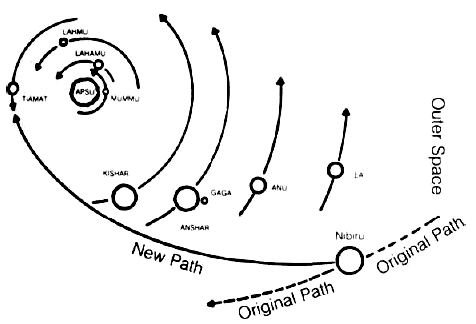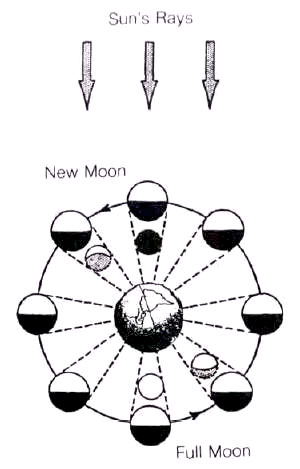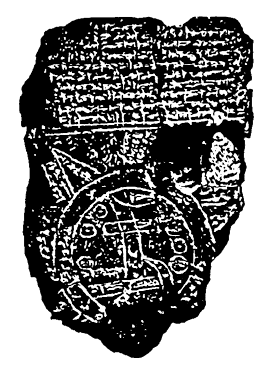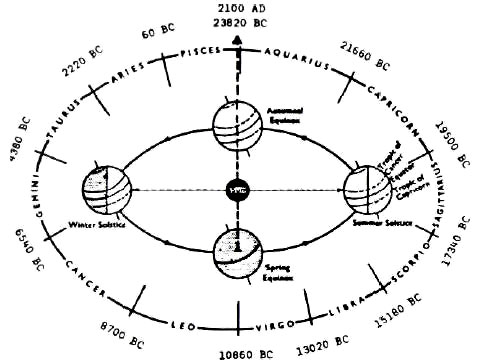|
1 - The Cycles of Time
Were, then, the pharaohs right?
As those
newly-created "celestial gods" tugged and pulled at each other, some
of them sprouted satellites - moonlets. Tiamat, in the midst of that
unstable planetary family, sprouted eleven satellites; one of them,
"Kingu," grew so much in size that it began to assume the aspects of
a "celestial god," a planet, on its own. Modern astronomers were
totally ignorant of the possibility that a planet could have many
moons until Galileo discovered the four largest moons of Jupiter in
1609, with the aid of a telescope; but the Sumerians were aware of
the phenomenon millennia earlier.
And so, Enuma elish related, one such cast-off planet, reaching the outskirts of our own Solar System, began to be drawn into its midst (Fig. 1).
Fig. 1
As it passed by the outer planets, it caused changes that account for many of the enigmas that still baffle modern astronomy - such as the cause for Uranus's tilt on its side, the retrograde orbit of Neptune's largest moon, Triton, or what pulled Pluto from its place as a moonlet to become a planet with an odd orbit.
The more the invader was drawn into the Solar System's center, the more was it forced onto a collision course with Tiamat, resulting in the "Celestial Battle." In the series of collisions, with the invader's satellites repeatedly smashing into Tiamat, the olden planet split in two. One half of it was smashed into bits and pieces to become the Asteroid Belt (between Mars and Jupiter) and various comets; the other half, wounded but intact, was thrust into a new orbit to become the planet we call Earth ("Ki" in Sumerian); shunted with it was Tiamat's largest satellite, to become Earth's Moon.
The invader
itself was caught into permanent orbit around the Sun, to become our
Solar System's twelfth member (Sun, Moon, and ten planets). The
Sumerians called it Nibiru - "Planet of the Crossing." The Babylonians
renamed it Marduk in honor of their national god. It was during the
Celestial Battle, the ancient epic asserted, that the "seed of
life," brought by Nibiru from elsewhere, was passed to Earth.
If the universe has existed forever, without a
beginning and thus without an end, is Time too without a beginning
and without an end - or did the universe indeed have a beginning,
perhaps with the Big Bang assumed by many astrophysicists, in which
case Time began when the universe began?
It must have taken great scientific minds to conceive of a primordial phase when "naught existed but primordial Apsu, their begetter; Mummu, and Tiamat" - when Earth had not yet come into being; and to realize that for Earth and all upon it the "big bang" was not when the universe or even the Solar System was created, but the event of the Celestial Battle.
It was then, at that moment, that
Time began for Earth - the moment when, separated from the half of Tiamat that became the Asteroid Belt ("heaven"), Earth was shunted
to its own new orbit and could start counting the years, the months,
the days, the nights - to measure Time.
Another text, in words often repeated on Sumerian clay tablets,
conveyed the notion of Beginning by listing the many aspects of
evolution and civilization that had not yet come into being before
the crucial event. Before then, the text asserted, "the name of Man
had not yet been called" and "needful things had not yet been
brought into being." All those developments started to take place
only "after heaven had been moved away from Earth, after Earth had
been separated from heaven."
This knowledge, universal in antiquity and stemming from the Sumerian cosmogony, was echoed in the very first verse of Genesis, the first book of the Hebrew Bible:
It is now well established that this biblical tale of creation was
based on Mesopotamian texts such as Enuma elish, with Tehom meaning
Tiamat, the "wind" meaning "satellites," in Sumerian, and "heaven,"
described as the "hammered out bracelet," the Asteroid Belt. The
Bible, however, is clearer regarding the moment of the Beginning as
far as Earth was concerned; the biblical version picks up the
Mesopotamian cosmogony only from the point of the separation of the
Earth from the Shama'im, the Hammered Bracelet, as a result of the
breakup of Tiamat.
Indeed, as a large planet that encompasses by its orbit all the other planets, one who "crosses the heavens and surveys the regions," it was considered to have become the one that stabilized the Solar System:
Thus, states Enuma elish (Tablet V, line 65), "He created the Heaven
and the Earth" - the very same words used in the Book of Genesis.
They would exit through the Valhalla's 540 doors; eight hundred warriors would march out of each. The total number of warrior-heroes, Santillana and von Dechend pointed out, was thus 432,000. "This number," they continued, "must have had a very ancient meaning, for it is also the number of syllables in the Rigveda," the "Sacred Book of Verses" in the Sanskrit language, in which have been recorded the Indo-European tales of gods and heroes.
Four hundred thirty-two thousand, the two
authors wrote, "goes back to the basic figure 10,800, the number of
stanzas in the Rigveda, with 40 syllables to a stanza" (10,800 x 40
= 432,000).
All in all these Hindu
traditions envision ten eons, paralleling the ten Sumerian rulers of
the pre-Diluvial era but expanding the overall time span to
4,320,000 years.
This brings to mind the enigmatic statement in Psalms (90:4) regarding the Divine Day of the biblical Lord:
The statement has traditionally been viewed as merely symbolic of the Lord's eternity. But in view of the numerous traces of Sumerian data in the Book of Psalms (as well as in other parts of the Hebrew Bible), a precise mathematical formula might well have been intended - a formula echoed also in Hindu traditions.
The Hindu traditions were brought to the Indian subcontinent by "Aryan" migrants from the shores of the Caspian Sea, cousins of the Indo-Europeans who were the Hittites of Asia Minor (today's Turkey) and of the Hurrians of the upper Euphrates River, through whom Sumerian knowledge and beliefs were transmitted to the Indo-Europeans.
The Aryan migrations are believed to have taken place in the second millennium BC. and the Vedas were held to be "not of human origin," having been composed by the gods themselves in a previous age. In time the various components of the Vedas and the auxiliary literature that derived from them (the Mantras, Brahmanas, etc.) were augmented by the non-Vedic Puranas ("Ancient Writings") and the great epic tales of the Mahabharata and Ramayana. In them, ages deriving from multiples of 3,600 also predominate; thus, according to the Vishnu Purana, "the day that Krishna shall depart from Earth will be the first day of the age of Kali; it will continue for 360,000 years of mortals."
This is a reference to the concept that the Kaliyuga, the present age, is divided to a dawn or "morning twilight" of 100 divine years that equal 36,000 Earth or "mortal" years, the age itself (1,000 divine years equaling 360,000 Earth-years), and a dusk or "evening twilight" of a final 100 divine years (36,000 mortal-years), adding up to 1,200 divine or 432,000 Earth-years.
The depth of such widespread beliefs in a Divine Cycle of 432,000 years, equaling 120 orbits of 3,600 Earth-years The Cycles of Time 13 each of Nibiru, makes one wonder whether they represent merely arithmetical sleights of hand - or, in some unknown way, a basic natural or astronomical phenomenon recognized in antiquity by the Anunnaki. We have shown in The 12th Planet, the first book of The Earth Chronicles series, that the Deluge was a global calamity anticipated by the Anunnaki, resulting from the gravitational pull of the nearing Nibiru on the unstable ice sheet over Antarctica.
The event brought the last ice age to an abrupt end circa 13,000 years ago, and was thus recorded in Earth's cycles as a major geological and climatic change. Such changes, the longest being the geological epochs, have been verified through studies of the Earth's surface and oceanic sediments. The last geological epoch, called the Pleistocene, began about 2,500,000 years ago and ended at the time of the Deluge; it was the time span during which hominids evolved, the Anunnaki came to Earth, and Man, Homo sapiens, was brought into being.
And it was during the Pleistocene that a cycle of approximately 430,000 years was identified in marine sediments. According to a series of studies by teams of geologists led by Madeleine Briskin of the University of Cincinnati, sea level changes and deepsea climatic records show a "430,000-year quasi-periodic cyclicity." Such a cyclic periodicity conforms with the Astronomical Theory of climatic modulations that takes into account changes due to obliquity (the Earth's tilt), precession (the slight orbital retardation), and eccentricity (the shape of the elliptical orbit).
Milutin Milankovitch, who outlined the theory in the 1920s, estimated that the resulting grand periodicity was 413,000 years. His, and the more recent Briskin cycle, almost conform to the Sumerian cycle of 432,000 Earth-years attributed to Nibiru's effects: the convergence of orbits and perturbations and climatic cycles.
The "myth" of Divine Ages thus appears to be based on scientific facts. The element of Time features in the ancient records, both Sumerian and biblical, not only as a point of beginning - When." The process of creation is at once linked to the measurement of time, measurements that in turn are linked to determinable celestial motions. The destruction of Tiamat and the ensuing creation of the Asteroid Belt and Earth required, according to the Mesopotamian version, two return orbits of the Celestial Lord (the invading Nibiru/Marduk).
In the biblical version, it
took the Lord two divine "days" to complete the task; hopefully,
even Fundamentalists will by now agree that these were not day and
night days as we now know them, for the two "days" occurred before
Earth had yet come into existence (and besides, let them heed the
Psalmist's statement of the Lord's day being equal to a thousand
years or so). The Mesopotamian version clearly measures Creation
Time or Divine Time by the passages of Nibiru, in an orbit equaling
3,600 Earth-years.
We now know that the Moon is always there, even when
unseen, and that it wanes and waxes not because it disappears but
because, depending on the Earth-Moon-Sun positions (Fig. 2) we see
the Moon fully lighted by the Sun's rays, or fully obscured by the
Earth's shadow, or in phases in between. It is this threefold
relationship that extends the actual orbital period of the Moon
around the Earth from about 27.3 days (the "sidereal month") to the
observed cycle of about 29.53 days (the "synodic month") and the
phenomenon of the reappearing or New Moon with all its calendrical
and religious implications. And the year or Solar Year, we now of
course know, is the period it takes the Earth to complete one orbit
around the Sun, our star.
The suggestion by Nicolaus Copernicus that the Sun was at the center and that the
Earth was just another celestial body orbiting it,
like any other planet, was so revolutionary scientifically and
heretical religiously that he delayed writing his great astronomical work (De revolutionibus coelestium; English translation,
On the Revolutions of Celestial Spheres) and his friends delayed
printing it until his very last day, May 24,1543.
Fig. 2
These motions were attributed to the "destinies" (orbits) that the Celestial Lord (Nibiru) gave Earth and its moon as a result of the Celestial Battle:
"Thus," the ancient text concludes, did the Celestial Lord "appoint
the days and establish the precincts of night and day."
The Hebrew term Mo'edim used here to denote "months," which signifies the ritual assembly called for on the evening of the New Moon, establishes the Moon's orbital period and phases as an integral component of the Mesopotamian-Hebrew calendar from its very inception. By listing the two luminaries (Sun and Moon) as responsible for the months and the days and the years, the complex lunar-solar nature of that calendar's antiquity is also presented.
Over the millennia of Mankind's efforts to measure time by devising a calendar, some (as the Moslems continue to this day) have followed only the Moon's cycles; others (as the ancient Egyptians and the Common Era calendars in use in the Western world) have adopted the solar year, conveniently dividing it into "months." But the calendar devised about fifty-eight hundred years ago in Nippur (Sumer's religious center) and still adhered to by the Jews retained the biblically stated complexity of time-keeping based on the orbital relationship between the Earth and the two luminaries.
In doing
that, the fact that the Earth orbits the Sun was recognized by the
term Shanah for "year" which stems from the Sumerian
shatu, an
astronomical term meaning "to course, to orbit," and the full term
Tekufath ha-Shanah - "the circling or annual orbiting" to denote the
passage of a full year.
Some two hundred fifty years before Copernicus asserted that the day-night sequence resulted not from the Sun's circling of the Earth but from the Earth's turning on its own axis, the Zohar stated that,
The Zohar's source was the third century Rabbi Hamnuna!
Though little known, the role of Jewish savants in transmitting astronomical knowledge to Christian Europe in the Middle Ages has been convincingly documented by extant books on astronomy, written in Hebrew and containing clear illustrations (as this one from a twelfth century book published in Spain, Fig. 3).
Fig. 3
Indeed, the writings of Ptolemy of Alexandria, known to the Western world as the Almagest, were first preserved by the Arab conquerors of Egypt in the eighth century and became available to Europeans through translations by Jewish scholars; significantly some of these translations contained commentaries casting doubt on the accuracy of the geocentric theories of Ptolemy centuries before Copernicus.
Other such translations of Arabic and Greek works on astronomy, as well as independent treatises, were a main channel for the study of astronomy in medieval Europe. In the ninth and tenth centuries Jewish astronomers composed treatises on the movements of the Moon and the planets and calculated the paths of the Sun and the positions of the constellations. In fact, the compilation of astronomical tables, whether for European kings or Moslem caliphs, was a specialty of Jewish court astronomers.
Such advanced knowledge, seemingly ahead of its time, can be explained only by the retention of the earlier sophisticated knowledge that permeates the Bible and its earlier Sumerian sources. Indeed, Kabbalah literally means "that which was received," earlier secret knowledge transmitted from generation to generation. The knowledge of Jewish savants in the Middle Ages can be traced directly to academies in Judea and Babylonia that commented upon and retained biblical data.
The Talmud, recording such data and commentaries from about 300 BC. to about a.d. 500, is replete with astronomical snippets; they include the statement that Rabbi Samuel "knew the paths of heaven" as if they were the streets of his town, and the reference by Rabbi Joshua ben-Zakai to "a star which appears once in seventy years and confounds the mariners" - familiarity with Halley's Comet whose periodic return every seventy-five years or so was assumed to have been unknown until discovered by Edmund Halley in the eighteenth century.
Rabbi Gamliel of Jabneh possessed a tubular optical instrument with which he observed the stars and planets - fifteen centuries before the "official" invention of the telescope. The need to know the heavenly secrets stemmed from the lunar-solar nature of the Jewish (i.e. Nippurian) calendar, which required a complex adjustment - "intercalation" - between the solar year and the lunar year, the latter falling short of the former by 10 days, 21 hours. 6 minutes and about 45.5 seconds.
That shortfall equals 7/19 of a synodic month, and, therefore, a lunar year can be realigned with
the solar year by adding seven lunar months to every nineteen
solar years. Astronomy books credit the Athenian astronomer Meton (circa 430 BC.) with the discovery of this
nineteen-year cycle; but the knowledge in fact goes back millennia,
to ancient Mesopotamia.
The discovery of the solstices has also been attributed to Meton and his colleague, the Athenian astronomer Euctemon. But, in fact, such knowledge goes back to much earlier times. The rich astronomical vocabulary of the Talmud had already applied the term Neti'yah (from the verb Natoh, "to tilt, incline, turn sideways") to the modern equivalent term "obliquity"; a millennium earlier the Bible recognized the notion of the Earth's axis by attributing the day-night cycle to a "line" drawn through the Earth (Psalms 19:5); and the Book of Job, speaking of the formation of the Earth and its mysteries, attributed to the Celestial Lord the creation of an inclined line, a tilted axis, for the Earth (Job 38:5).
Using the term Natoh, the Book of Job refers to the Earth's tilted axis and the North Pole when it states (26:7)
Psalms 74:16-17 recognized not only the correlation between the Earth, Moon, and Sun, and the Earth's rotation about its axis as the cause of day, night, and the seasons, but also recognized the outermost points, the "limits" of the Sun's apparent seasonal movements, that we call solstices:
If a line is drawn between the sunrise and sunset points for each solstice, the result is such that the two lines cross above the viewer's head, forming a giant X that divides the Earth, and the skies above it, into four parts. This division has been recognized in antiquity and is referred to in the Bible when it speaks of the "four corners of the Earth" and the "four corners of the skies."
The
resulting division of the circle of the Earth and the skies into
four parts that look like triangles rounded at their bases created
for the ancient peoples the image of "wings." The Bible thus spoke
of the "four wings of the Earth" as well as of the "four wings of
the skies."
Figure 4 The Sun's apparent movement from north to south and back resulted not only in the two clearly opposite seasons of summer and winter, but also the interim seasons of autumn and spring. The latter were associated with the equinoxes, when the Sun passed over the Earth's equator (once going, once coming back) - times at which daylight and nighttime are equal. In ancient Mesopotamia, the New Year began on the day of the spring equinox - the first day of the First Month (Nisannu - Month "when the sign is given").
Even when, at the time of
the Exodus, the Bible (Leviticus chapter 23) decreed that the New
Year be celebrated on the day of the autumnal equinox, that
designated month (Tishrei) was called "the seventh month,"
recognizing that Nisannu has been the first month. In either case,
the knowledge of the equinoxes, attested to by the New Year days,
clearly extends back to Sumerian times.
But what could they do somehow to create a reason
able relationship, other than 1:3600, between that Divine Time and
the Earthly Time?
Devising the division of the ecliptic (the plane of planetary orbits around the Sun) into twelve - to conform to the twelve-member composition of the Solar System - the Anunnaki invented the twelve houses of the zodiac; that allotted to each zodiac house 30°, in consequence of which the retardation per house added up to 2,160 years (72 x 30 = 2,160) and the complete Precessional Cycle or "Great Year" to 25,920 years (2,160 x 12 = 25,920).
In Genesis Revisited we have suggested that by relating 2,160 to 3,600 the Anunnaki arrived at the Golden Ratio of 6:10 and, more importantly, at the sexagesimal system of mathematics which multiplied 6 by 10 by 6 by 10 and so on and on.
The "miracle," as we have since shown, was provided
by
the advanced knowledge of the Anunnaki.
It was so through the Hameshtu, the "fiver" or "times five," he
wrote, creating the fundamental number 360 by multiplying the
celestial 72 (the precessional shift of 1°) by the human 5 of an
Earthling's hand. His insight, understandably for his time, did not
lead him to envision the role of the Anunnaki, whose science was
needed to know of Earth's retardation to begin with.
He, and others, had no doubt that the phenomenon of precession, presumably first mentioned by the Greek Hipparchus in the second century BC., was already known and followed in Sumerian times. The number, reduced by ten to 1,296,000, it will be recalled, appears in Hindu tradition as the length of the Age of Knowledge as a threefold multiple of the cycle of 432,000 years.
The
cycles-within-cycles, interplaying 6 and 12 (the 72 years of a 1°
zodiacal shift), 6 and 10 (the ratio of 2,160 and 3,600) and 432,000
to 12,960,000, may thus reflect small and great cosmic and
astronomical cycles - secrets yet to be unveiled, of which Sumerian
numbers offer just a glimpse.
Although this point is still being referred to as the First Point of Aries, in fact we have been in the "Age" (or zodiac) of Pisces since about 60 BC., and slowly but surely we will soon enter the Age of Aquarius (Fig. 5). It is such a shift - the change from a fading zodiacal age to the start of another zodiacal age - that is the coming of a New Age.
Figure 5
As Mankind on Earth awaits the change with anticipation, many are those who wonder what the change will bring with it - of what Mazal will it be a harbinger? Bliss or upheavals, an end - or a new beginning? The end of the Old Order or the start of a New Order on Earth, perhaps the prophesied return of the Kingdom of Heaven to Earth? Does Time only flow forward or can it also flow back-ward, philosophers have wondered.
In fact, Time does shift backward, for that is the essence of the phenomenon of precession: the retardation in Earth's orbit around the Sun that causes, once in about 2,160 years, the observance of sunrise on the spring equinox not in the next zodiacal house but in the preceding one... Celestial Time, as we have designated it does not progress in the direction of Earthly (and all Planetary) Time, counterclockwise; rather, it moves in the opposite direction, matching the orbital (clockwise) direction of Nibiru.
Celestial Time does flow backward, as far as we on Earth are concerned; and therefore, in zodiacal terms, the Past is the Future.
Let us examine the Past.
|




